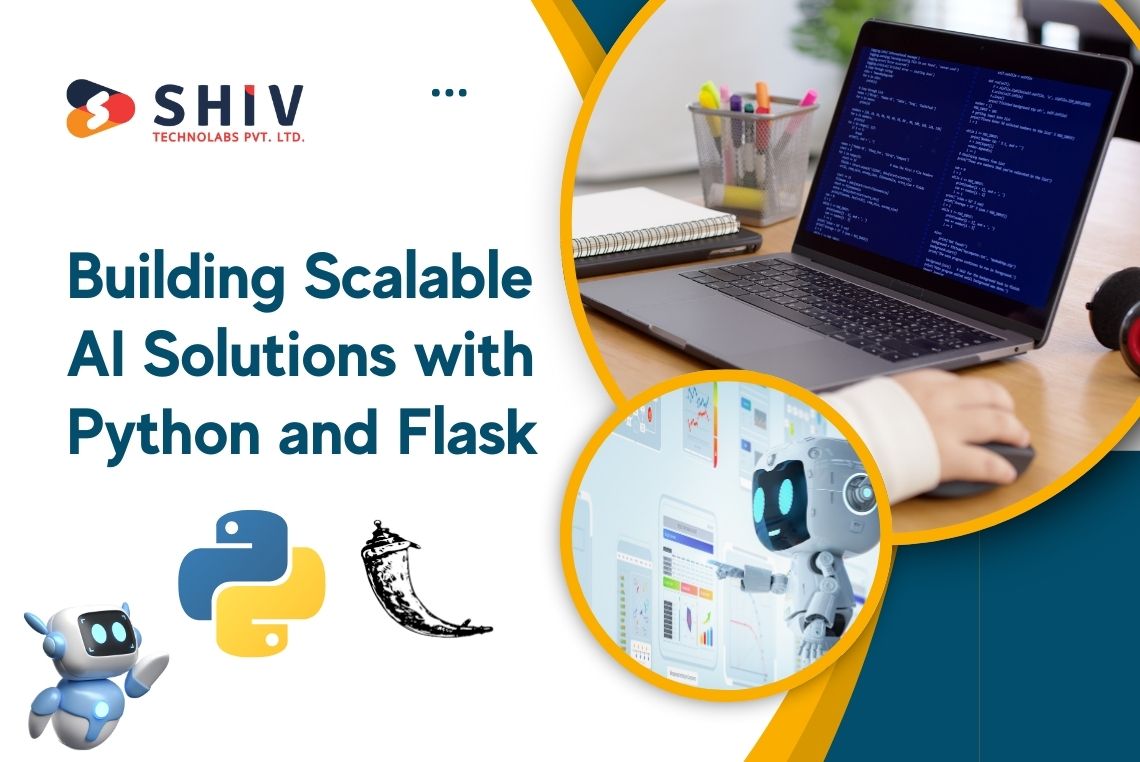Table of Contents
Artificial Intelligence (AI) has quickly become a vital component in modern web applications, from personalized recommendations to intelligent chatbots. Flask, a lightweight Python web framework, is a popular choice for building web applications, and when combined with AI capabilities, it offers powerful solutions for a variety of industries.
In this blog, we will discuss how you can build scalable AI solutions with Python and Flask. From designing the architecture to implementing AI algorithms and handling large-scale requests, we will cover everything you need to know for deploying effective AI applications.
Introduction to Flask and AI Integration

Flask is a micro-framework in Python, best known for its simplicity, flexibility, and ease of use. Its minimalistic design makes it an ideal choice for integrating with external libraries such as those required for machine learning and AI.
On the other hand, Python has become the language of choice for AI development. It offers a rich set of libraries and frameworks like TensorFlow, PyTorch, Scikit-learn, and more. These libraries provide the tools needed for building complex machine learning models.
Combining Flask with Python’s AI capabilities allows developers to build and scale web applications that can serve AI-based predictions or data analytics.
Architecture of AI-Powered Flask Applications
Before diving into the code, understanding the architecture of an AI-powered Flask application is essential. A typical setup for a scalable AI solution might include the following components:
- Frontend: The user interface, typically built using HTML, CSS, and JavaScript, that interacts with the backend Flask application.
- Flask Backend: The core of the application, where the AI logic is implemented. Flask handles API endpoints and manages communication between the frontend and AI models.
- AI Model: The machine learning or deep learning models responsible for tasks like classification, regression, or recommendations. These models are trained in Python using libraries such as TensorFlow, Keras, or Scikit-learn.
- Database: For storing data, including model inputs, outputs, and other user information. Common choices include MySQL, PostgreSQL, and MongoDB.
- Caching and Queueing: For scalability, solutions like Redis or RabbitMQ can be integrated to handle heavy traffic and asynchronous task execution.
- Cloud Services: Deploying the AI Flask application on cloud services like AWS, Google Cloud, or Azure ensures high availability and scalability.
Building Your First AI-Powered Flask Application

Let’s start by building a simple Flask application that integrates an AI model. This model will predict house prices based on a dataset using Scikit-learn. The Flask app will take user input, feed it to the AI model, and return predictions.
Step 1: Set Up the Flask Environment
First, ensure you have Python and Flask installed. You can install Flask and necessary libraries using pip:
pip install flask scikit-learn pandas
Create a basic Flask app:
from flask import Flask, request, jsonify
import pickle
import pandas as pd
app = Flask(__name__)
# Load pre-trained AI model (House Price Prediction Model)
model = pickle.load(open('house_price_model.pkl', 'rb'))
@app.route('/')
def home():
return "Welcome to the AI-Powered Flask Application"
@app.route('/predict', methods=['POST'])
def predict():
data = request.json
input_data = pd.DataFrame([data])
prediction = model.predict(input_data)
return jsonify({'prediction': prediction[0]})
if __name__ == '__main__':
app.run(debug=True)
This basic Flask application accepts input data from users in JSON format, feeds it to the pre-trained AI model, and returns the prediction.
Step 2: Train the AI Model
For this example, let’s create a simple machine learning model that predicts house prices using the Boston dataset. Use Scikit-learn to train the model:
from sklearn.datasets import load_boston
from sklearn.model_selection import train_test_split
from sklearn.linear_model import LinearRegression
import pickle
# Load dataset
boston = load_boston()
X = boston.data
y = boston.target
# Split the data
X_train, X_test, y_train, y_test = train_test_split(X, y, test_size=0.2, random_state=42)
# Train a linear regression model
model = LinearRegression()
model.fit(X_train, y_train)
# Save the trained model
pickle.dump(model, open('house_price_model.pkl', 'wb'))
Once the model is saved, the Flask application can load and use it to make predictions.
Scaling AI Solutions
Building AI applications for a few users is one thing, but scaling them for thousands or even millions of users requires careful consideration. Flask, by itself, is lightweight and not designed for heavy workloads. To ensure scalability, follow these steps:
1. Use Asynchronous Requests
Handling AI predictions, especially complex models, can be time-consuming. Using asynchronous task queues like Celery helps offload these tasks to background workers, freeing up the main Flask app to serve new requests. Celery integrates seamlessly with Flask.
pip install celery redis
Modify the Flask app to use Celery:
from celery import Celery
from flask import Flask, request
app = Flask(__name__)
celery = Celery(app.name, broker='redis://localhost:6379/0')
@app.route('/predict_async', methods=['POST'])
def predict_async():
data = request.json
task = async_predict.delay(data)
return jsonify({'task_id': task.id})
@celery.task
def async_predict(data):
input_data = pd.DataFrame([data])
prediction = model.predict(input_data)
return prediction[0]
With this setup, predictions run asynchronously in the background, improving response times and user experience.
2. Containerization
Packaging the Flask app and AI model into containers using Docker is essential for consistency and scalability. Containers ensure that your application runs identically across different environments.
# Dockerfile for Flask and AI app FROM python:3.8 WORKDIR /app COPY . /app RUN pip install -r requirements.txt CMD ["python", "app.py"]
You can easily scale this Docker container using container orchestration tools like Kubernetes, ensuring that your application can handle heavy traffic.
3. Load Balancing
As your AI application grows, handling multiple requests simultaneously can overwhelm a single instance. Load balancing helps distribute traffic across multiple Flask instances. Tools like Nginx or HAProxy can be used to balance traffic and ensure high availability.
4. Caching with Redis
To reduce the time it takes to serve AI predictions, caching results using Redis can drastically improve performance. This is particularly useful for predictions that are frequently requested.
pip install redis
Add caching functionality to your Flask app:
import redis
cache = redis.StrictRedis(host='localhost', port=6379, db=0)
@app.route('/predict_with_cache', methods=['POST'])
def predict_with_cache():
data = request.json
cache_key = str(data)
cached_prediction = cache.get(cache_key)
if cached_prediction:
return jsonify({'prediction': cached_prediction.decode('utf-8')})
input_data = pd.DataFrame([data])
prediction = model.predict(input_data)
cache.set(cache_key, prediction[0])
return jsonify({'prediction': prediction[0]})
Real-World Applications
Flask combined with AI models has been deployed in various industries:
- Healthcare: Flask serves as a backend for applications that predict patient outcomes, diagnose diseases, and provide personalized treatment plans.
- Finance: AI-driven Flask applications analyze market data, detect fraud, and provide stock price predictions.
- Retail: Flask applications utilize AI models for product recommendations, customer behavior analysis, and dynamic pricing strategies.
- Logistics: AI-powered applications help optimize delivery routes, predict demand, and streamline supply chain operations.
Conclusion
Building scalable AI applications using Flask and Python provides a robust solution for businesses looking to implement intelligent systems into their workflows. By utilizing Flask’s flexibility and Python’s AI libraries, you can build, deploy, and scale solutions that meet growing demand.
To build high-performing, scalable AI applications, focus on using asynchronous task handling, containerization, and load balancing. With these strategies, your Flask application will not only serve accurate AI predictions but also maintain responsiveness under heavy load.
For scalable and efficient AI solutions, partner with Shiv Technolabs, a trusted Python development company in USA. We specialize in delivering robust, AI-powered web applications tailored to your needs. Whether you’re starting a new project or scaling an existing one, hire dedicated Python developers from our expert team to ensure top-notch performance and seamless integration for your business. Let us help you bring your AI vision to reality.




















